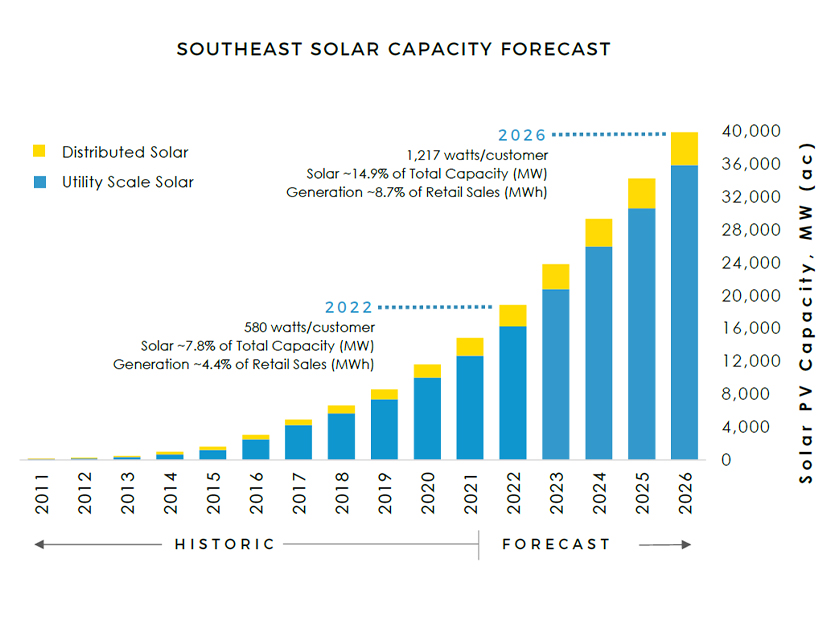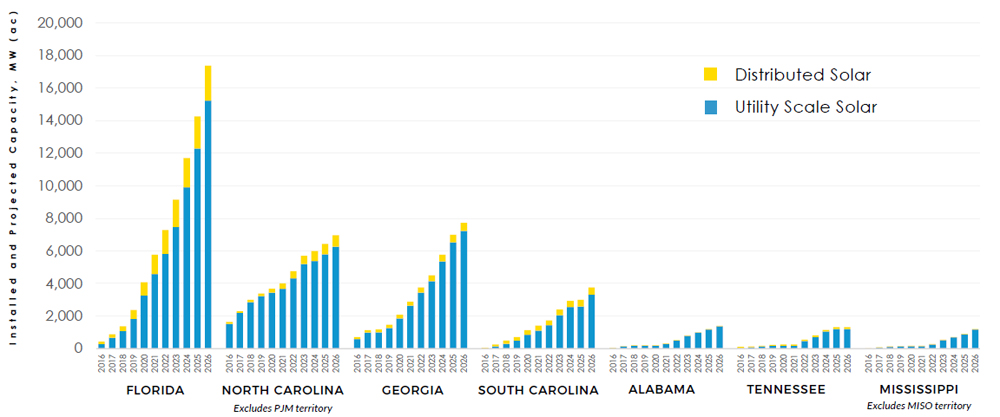The Southeast’s solar capacity will more than double by 2026, according to the Southern Alliance for Clean Energy’s (SACE) sixth report on solar energy development.
The report released Wednesday forecasts growth to 40 GW of capacity by 2026, more than double the 18.8 GW claimed last year. Available watts/customer (W/C) are expected to increase as well, from 580 last year to 1,217 in 2026. SACE Executive Director Steve Smith described this rise as a “generational transition” in more than one sense.
“You have to be part of the clean energy generation, both in a generational sense where each and every one of us are part of the generation to actually seize this moment and create change,” Smith said. “But then also we’ve got to get more literally physical clean energy generation on the ground.”
This growth, the report says, is due largely to two federal moves: The implementation of the Inflation Reduction Act (IRA); and a two-year moratorium on import duties from Vietnam, Cambodia, Thailand and Malaysia that “helped the U.S. solar industry regain its footing after an extended supply chain disruption.”
Within the IRA, production and investment tax credits were returned to their full valuation of 30% and extended out to 2032, which “provided certainty into the market that the market really needs,” said Bryan Jacob, SACE’s solar program director.
The IRA also contains a $9.7 billion grant for rural electric co-ops, which Jacob said may be “the most transformational program for rural America since the Rural Electrification Act itself, back in 1936.”
The steep increase in available solar capacity in the next four years will not be evenly borne by the states in the Southeast, the report showed. Driven by policies such as solar base rate adjustment, said Jacob, Florida will increase its capacity to more than 17 GW by 2026, “almost as much as the entire Southeast region had last year.”
North Carolina, Georgia and South Carolina are also projected to increase their capacity dramatically, with Georgia slated to overtake North Carolina in both total capacity and watts/customer by 2026. Alabama, Tennessee and Mississippi “continue to fall far short of other Southeast states in both installed capacity MW as well as watts per customer (W/C) solar ratio,” the report said.
When asked to elaborate on the latter projection, Smith said he has not seen these states’ utilities “look at solar as a workhorse resource yet,” adding that many utilities are “inappropriately planning for what the future is unfolding to be,” and “making the wrong bets” on fossil fuels.
Sunblockers and Sunrisers
SACE’s report highlights several of these lagging utilities as “Sunblockers” — utilities with more than 500,000 customers with a four-year projected W/C ratio less than the Southeast’s average for last year (580).
Alabama Power and the North Carolina Electric Cooperative remain on this list from last year, at 331 and 197 W/C respectively, with PowerSouth joining them at 169 W/C. While Tennessee Valley Authority and Seminole Electric “remain considerably below the region averages,” at 658 and 600 W/C, the report said, they are not quite Sunblockers technically.
The opposite category also exists: “Sunrisers,” or the seven utilities with the largest projected increase in W/C solar ratio. Walton EMC, projected to increase its ratio by more than 4,000 W/C, retained its large lead. The second-largest increase was 1,564 W/C by the Knoxville Utilities Board. New to the Sunrisers list is Santee Cooper, due both to the utility’s own plan and commissioned solar development. The Sunrisers list is not constrained by customer base size as is the Sunblockers list.
However, these projections are not set in stone, Jacob said, as “the most important contributor to the forecast is integ resource plans (IRPs) that we have access to.” Because of the IRA’s recency, some utilities “haven’t had a resource planning process since August of last year, when the Inflation Reduction Act was signed.”
Georgia Power, for example, will not have a new resource planning process until 2025, while Duke will file its first IRPs aligned with its new Carbon Plan on Aug. 1 and Sept. 1 for South Carolina and North Carolina.
So, while some growth is reflected in the forecast, Jacob said, “We’re gonna see a lot more for kind of the back half of the decade. That being said, the current forecast out to 2026 is already super bullish.”



